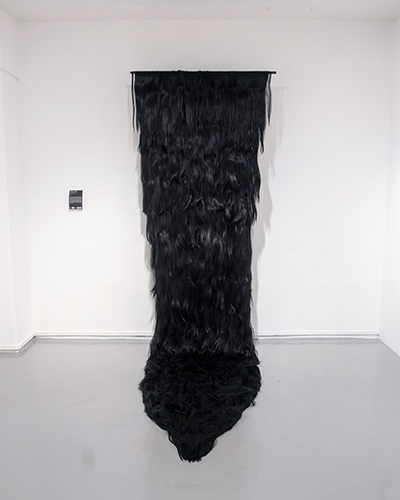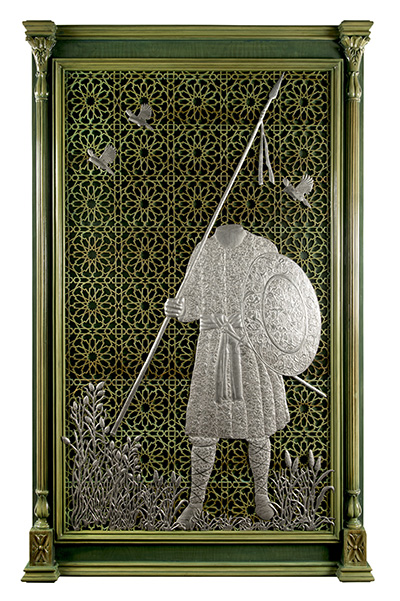By Aditi Shivaramakrishnan
(1,200 words, 5-minute read)
When it comes to analysing an artwork, the artist’s choice of materials can be as revelatory as other elements in suggesting what they might wish to communicate. Two forthcoming shows due to open during Singapore Art Week 2020 are good examples of how and why materials matter.
Happening from 10 to 19 January, the IMPART Collectors’ Show 2020, organised by Art Outreach, draws on 13 private collections around the world and presents works by 19 renowned artists. Themed Material Agendas, it squarely focuses on the “transgressive spirit” of “artists testing the limits of material possibilities”, says its curatorial advisor, Director of the Asia Society Museum in New York, Tan Boon Hui. The choice of materials is often deliberate and purposeful, reflecting various considerations of form, meaning, histories and possibilities. The show, held at the School of the Arts (SOTA) Gallery, has free admission.
Over at The Arts House, renowned British-Nigerian contemporary artist Yinka Shonibare’s new site-specific installation titled Justice for All, curated by London-based art historian and critic Dr Zehra Jumabhoy, requires close attention to the details of its material – a regional spin on Shonibare’s classic Dutch wax batik – in a discussion of authenticity in the wake of colonialism. The installation, which takes place from 13 to 30 January, is free to enter.
Here’s a look at seven artworks from these shows and what the materials used tell us:

1. I’ve Seen an Elephant Fly (2002) by Bharti Kher
Medium: Bindis on fibreglass life-sized baby elephant
Shumita and Arani Bose Collection, New York
British-Indian artist Bharti Kher’s practice spans different mediums and examines cultural misinterpretations. She repeats certain patterns in her works, and one of her primary materials are mass-produced bindis, a coloured dot traditionally worn on the foreheads of Hindu women but today more widely worn both culturally and decoratively. This work involved the painstaking application, over a number of months, of thousands of white bindis on a life-size fibreglass baby elephant: a process which also reveals and reminds us of the labour involved in making art. When used en masse on a life-sized replica of an animal associated — sometimes reductively — with India, these transcend their association with delicate femininity and strongly command our attention.
This work is part of the IMPART Collectors’ Show 2020.

2. Time is a Weight I Carry (2019) by Odelia Tang
Medium: Synthetic hair and tulle
Nijkerk-Bogen Collection
For Singaporean artist Odelia Tang, hair can be considered an alternative unit of measurement of time, and the growth and length of her hair serves as material proof of time passing. Despite its universality, hair is especially diverse in its forms, which impacts how individuals are perceived and move through the world both personally and politically. While symbolic of the passage of time, seen here in a disembodied state, it offers no clues about the life behind it. The title suggests that the work could be interpreted as expressing a certain anxiety about being forgotten, becoming anonymous after death.
This work is part of the IMPART Collectors’ Show 2020.

3. What Dreams May Come (2016) by Adeela Suleman
Medium: Wood carving and steel
Collection of Taimur Hassan
In this work by Pakistani artist Adeela Suleman, life and abundance as symbolised by the feminine motifs of birds and flowers are contrasted with the figure of a masculine warrior, whose headlessness perhaps suggests death. Temporality and delicateness as suggested by the use of wood are contrasted with the enduring quality of stainless steel. Suleman’s scene rendered in the filigree tradition of Islamic art confronts humans’ fears of mortality, but in contrast to Tang’s work, also suggests transcendence and salvation.
This work is part of the IMPART Collectors’ Show 2020.

4. Coins on Grandmother’s Cloth (1992) by El Anatsui
Medium: Mixed media on African hardwood
Private collection
For this work, Ghanaian Nigerian artist El Anatsui used a chainsaw to cut and carve planks of wood, and blackened and smoothened them with a torch, referencing the brutality with which Western colonisers divided up the African continent among themselves. The wood is treated with decorations in the style of “Uli”, which were traditionally almost exclusively produced by women, from Southeastern Nigeria. Anatsui’s choice of these motifs could be seen as a deliberate choice to highlight native knowledge — of women in particular.
This work is part of the IMPART Collectors’ Show 2020.

5. Saint Gregory the Great (2018) by Kehinde Wiley
Medium: Oil on canvas
Private collection
African American artist Kehinde Wiley is most recently known for his presidential portrait of Barack Obama, but has for many years now been reclaiming the use of large oil painting portraits to re-insert people of colour — specifically urban black men — into the art historical canon. As portrait paintings historically represent wealthy and powerful people, certain groups of people would have been excluded from, underrepresented or misrepresented in the canon. Wiley paints people of colour in proud poses referencing masterpieces, but in their own contemporary attire, thereby affording them legitimacy and respect as the individuals they are.
This work is part of the IMPART Collectors’ Show 2020.

6. Cupid Bending a Bow (2018) by Yinka Shonibare CBE
Medium: Unique cast fibreglass sculpture, hand-painted with Dutch wax batik pattern, bespoke hand-coloured globe and gold leaf
Private collection. Copyright of the artist.
In this work, British-Nigerian artist Yinka Shonibare has covered a classic-looking sculpture of a winged Cupid figure in a Dutch wax batik pattern, as is characteristic of his practice. During their colonial rule of Indonesia in the 19th century, the Dutch mass-produced textiles in the style of Indonesian batik. As these were poorly received in Indonesia, the Dutch sold them to West and Central African markets, where in the 1960s locals began to view them as a marker of authentic African identity and independence, and anticolonial nationalists adopted them for their attire. Shonibare demonstrates how with global flows of trade and information, a product of appropriation, rejected by one colony, can become a meaningful symbol in another.
This work is part of the IMPART Collectors’ Show 2020.

7. Justice for All (2019) by Yinka Shonibare CBE (detail of hand-painted batik pattern)
Medium: Fibreglass sculpture, hand-painted with batik pattern, hand-painted globe, brass and steel baseplate
Also speaking powerfully of coloniality is site-specific installation Justice for All, where Shonibare’s sculpture of Lady Justice, a reconfiguration of British sculptor F.W. Pomeroy’s sculpture of the same name, will hold court in the Chamber of the Arts House. Where Pomeroy’s formidable Lady Justice stands atop the dome of London’s Central Criminal Court (also known as Old Bailey) in a golden garment, Shonibare’s Lady Justice, situated in Singapore’s former Parliament House, sports his signature Dutch wax batik patterns while her body is painted in Javanese batik patterns – themselves hybrid in nature – which the Dutch later appropriated. In place of a head, Shonibare’s sculpture has a hand-painted globe, featuring a map of the world. Lady Justice is no longer just an emblem of colonial dominance, but a symbol of international trade and exchange, and evolving identities and relationships.
This work is part of Justice for All at The Arts House Chamber.

With such nuanced use of material, Shonibare undercuts ideas of authenticity and conveys how specificity matters. This is a highly relevant sentiment in these days when minority groups and the historically disempowered are not just seeking tokenistic representation but a more nuanced one that takes into account how various facets of identity intersect. As Tan Boon Hui says of contemporary materiality: “In this brave new world, one thing certainly does not look like another.”
In these two exhibitions, artists have deliberately selected materials with rich heritage, specific cultural symbolism and that are often intertwined with legacies of violence, oppression and erasure, and personal and political dislocation. Looking at these works more closely is both rewarding and important as it offers insight into highly particular contexts that are crucial in shaping the artists’ perspectives, aiding our understanding of what we see before us.
The IMPART Collectors’ Show 2020: Material Agendas returns for its third edition from 10 to 19 January 2020 at the School of the Arts (SOTA), Level 2, SOTA Gallery. The exhibition is open daily from 11am to 7pm. Admission is free. IMPART Collectors’ Show is organised by Art Outreach. More info here.
Justice for All by Yinka Shonibare CBE, RA takes place at The Arts House Chamber from 13 to 30 January 2020, 10am to 10pm. Admission is free. This site-specific installation is presented by The Asian Art Institutum, together with The Arts House and Stephen Friedman Gallery, London. More info here.
This post is sponsored by Art Outreach.
Aditi Shivaramakrishnan works as an arts manager, editor and writer in Singapore.
About the author(s)
Aditi Shivaramakrishnan (she/her/hers) works as an editor, writer, arts manager and speech-to-text-interpreter in Singapore.
She has been published in ArtsEquator, gal-dem, The New Paper, Portside Review and SINdie, and has conducted qualitative research, edited art books, comics and young adult fiction titles, developed educational programmes, managed marketing and communications, created content, done live note-taking, and moderated events for organisations including AWARE, Difference Engine, Epigram Books, Equal Dreams, Facebook, National Gallery Singapore, Objectifs Centre for Photography and Film, and the Singapore International Film Festival.
Find her at www.aditishiva.com.



